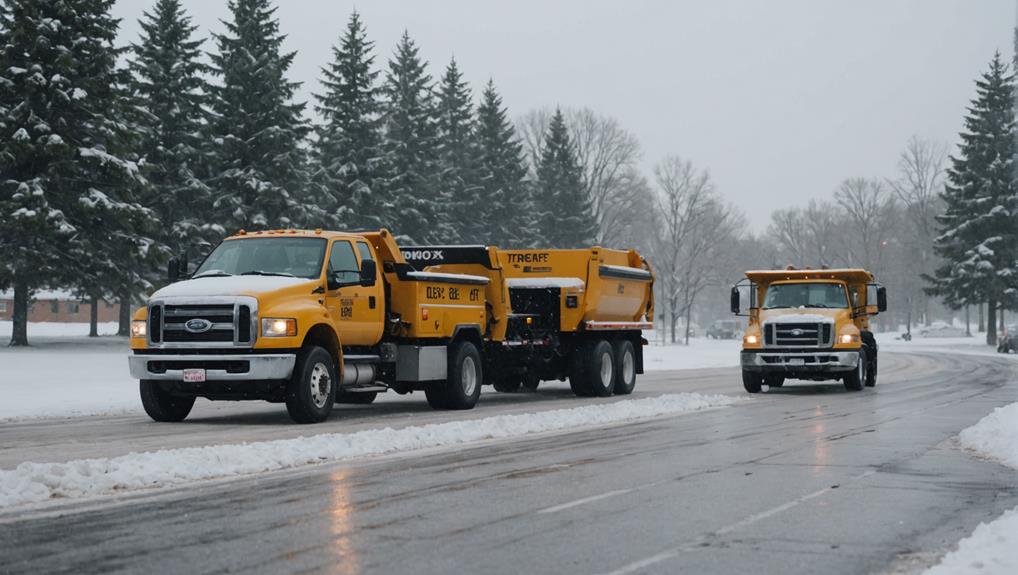
Table Of Contents
Snow Truck Maintenance
Regular maintenance of snow trucks is essential to ensure optimal performance during snow hauling operations. Checking the engine, brakes, and hydraulic systems should be a routine practice. Keeping an eye on fluid levels, including antifreeze and oil, helps prevent mechanical issues. Additionally, inspecting the truck’s undercarriage for salt and debris build-up can safeguard against corrosion, which can significantly impact longevity.
Tire condition is another critical aspect of snow truck maintenance. Drivers should regularly monitor tread depth and wear, as proper traction is vital for safety and efficiency during snow hauling. Also, ensuring that the plow attachment is in good working order can enhance the effectiveness of snow removal efforts. Taking the time to maintain equipment helps avoid costly repairs and downtime when the heaviest snowfall occurs.
Best Practices for Longevity
Regular maintenance is essential for extending the life of a snow truck. Operators should schedule routine inspections to identify any potential issues early. Essential components such as the engine, transmission, and hydraulic systems require attention. Changing the oil and filters at recommended intervals can prevent buildup that might compromise performance during snow hauling.
Additionally, keeping the snow truck clean contributes to its longevity. Road salt and grime can cause corrosion and damage over time. Washing the truck after each use, especially during winter months, helps remove these harmful substances. Protective coatings can also be applied to vulnerable areas to enhance resistance to harsh conditions encountered during snow hauling.
Operating a Snow Truck
Operating a snow truck requires a clear understanding of its capabilities and the conditions it faces. Snow hauling can be challenging, especially in heavy snowfall or icy conditions. Drivers must stay vigilant and maintain a steady pace to prevent sliding or losing control. Proper training is essential to ensure that operators can navigate various environments, from residential streets to large commercial lots. Awareness of the truck's size and the area being plowed is crucial in avoiding obstacles and ensuring an efficient snow removal process.
On the job, communication with team members can enhance efficiency and safety. Using hand signals or radios can help coordinate efforts while snow hauling, especially in crowded areas. Regular checks of the truck’s systems, including brakes, lights, and heating, contribute to effective operation. Attention to weather updates ensures that drivers handle changing conditions safely and make necessary adjustments to their route or strategy. Being proactive in addressing potential hazards helps minimize risks during snow removal tasks.
Tips for Effective Use
To ensure optimal performance while utilizing a snow truck, operators should focus on proper weight distribution. Heavy loads can affect the stability and handling of the vehicle. When preparing for snow hauling, evenly spread the weight across the truck bed. This promotes better traction and reduces the risk of damage during rough weather conditions.
Regular monitoring of the truck’s fluid levels is critical for effective use. Engine oil, coolant, and hydraulic fluids all play vital roles in maintaining performance, especially in extreme weather. Keeping these fluids at appropriate levels can prevent overheating and mechanical failures. This practice not only enhances the efficiency of snow hauling but also extends the overall lifespan of the vehicle.
Snow Truck Safety Protocols
Safety protocols for operating a snow truck are essential for ensuring the well-being of both the driver and those around them. Regular checks should be performed on equipment such as plows and salt spreaders. Proper maintenance reduces the risk of malfunctions. Drivers must also stay vigilant, especially in low visibility conditions. Clear communication with team members enhances coordination during snow hauling operations.
When engaging in snow hauling, it is crucial to be aware of the surrounding environment. Establishing clear routes and maintaining a safe distance from pedestrians and other vehicles can prevent accidents. Wearing appropriate safety gear, such as high-visibility jackets and sturdy footwear, adds an extra layer of protection. Conducting pre-trip inspections further contributes to a safer working environment.
Important Guidelines to Follow
When operating a snow truck, safety should always be a priority. Proper training is essential for all operators, ensuring they are familiar with the vehicle's mechanics and equipment used during snow hauling. Regular safety meetings can reinforce protocols, covering topics such as the importance of wearing seatbelts, maintaining clear visibility, and the need for careful navigation in icy conditions. Operators should also be aware of their surroundings, including other vehicles and pedestrians, to prevent accidents.
Maintaining an organized workspace within the snow truck contributes significantly to safety. All tools and equipment should be securely stored to avoid any shifting that may occur during travel. Additionally, keeping the cabin free from distractions aids in focusing on the road. Ensuring that all snow hauling equipment is in proper working order before each operation is critical. Regular checks and maintenance of these machines enhance their efficiency and, most importantly, the safety of everyone involved.
FAQS
What is a snow truck commonly referred to as?
A snow truck is often called a snowplow or snowplow truck, which is designed specifically for removing snow from roadways and other surfaces.
How does a snow truck differ from a regular truck?
A snow truck is equipped with a snowplow blade and often has features like enhanced traction, larger tires, and salt spreaders, making it suitable for snow removal tasks, unlike regular trucks.
What types of vehicles can be classified as snow trucks?
Snow trucks can include various types of vehicles, such as pickup trucks with plow attachments, dedicated snowplow vehicles, and larger trucks like dump trucks fitted with snow removal equipment.
Do snow trucks require special maintenance?
Yes, snow trucks require special maintenance, including regular checks on the plow mechanism, hydraulic systems, and salt spreaders, as well as ensuring that the vehicle's engine and tires are in good condition to handle winter conditions.
Can I use a regular truck for snow removal?
A regular truck can be used for snow removal if it is equipped with a snowplow attachment and appropriate tires, but it may not perform as effectively as a dedicated snow truck.




